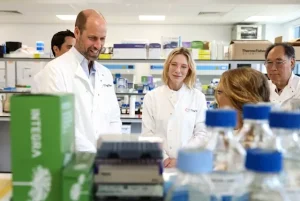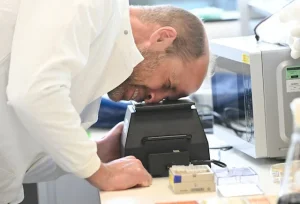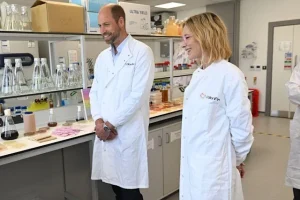Prince William Admits Regret During Lab Tour with Cate Blanchett: “I Should Have Paid More Attention in Chemistry”
During a recent visit to a cutting-edge sustainable textile company, Prince William made an honest confession about his academic past. Accompanied by Oscar-winning actress Cate Blanchett, the Prince of Wales toured the facilities of Colorifix, a UK-based biotech company pioneering eco-friendly dye technology. The royal visit not only highlighted the growing intersection of science, sustainability, and fashion but also offered a glimpse into William’s personality and his commitment to environmental initiatives.

A Royal and a Hollywood Star Unite for Sustainability
Prince William and Cate Blanchett, both advocates for environmental causes, arrived at Colorifix’s headquarters in Norwich wearing white lab coats and safety goggles. Blanchett, known not only for her acting career but also her activism, is a member of the Earthshot Prize Council, the prestigious environmental award founded by Prince William.
Their presence at the labs signaled strong support for innovative green technologies. Colorifix was a finalist in the 2023 Earthshot Prize, a competition that rewards the most ambitious and impactful solutions to climate and ecological challenges. The company’s mission centers on replacing harmful textile dyeing methods with a biological process that is more sustainable and less polluting.
The Colorifix Process: Nature Meets Biotechnology
The lab tour was divided into four stations, each demonstrating a step in the Colorifix dyeing process. The process starts by identifying colors in nature — such as those found in animals or plants — and then sequencing the DNA responsible for those colors.
This genetic information is transferred into safe, engineered microbes that can grow and multiply through fermentation. The end result is a liquid dye that can be applied to natural and synthetic fabrics — without the toxic chemicals typically used in conventional dyeing.
The biological approach pioneered by Colorifix has several key benefits:
-
Reduced water usage compared to traditional dyeing methods.
-
No harmful chemical discharge, which protects rivers and aquatic ecosystems.
-
Energy efficiency through room-temperature fermentation processes.

Prince William’s Chemistry Confession
As the Prince moved through the labs and engaged with scientists, including Colorifix’s Head of Microbial Engineering, Sophie Vaud, he found himself fascinated — and slightly regretful.
“Today has just made me realise I should have listened in all of my chemistry lessons,” William joked. He went on to admit that reviewing the scientific explanations made him think, “Damn, why didn’t I pay more attention?”
Though chemistry wasn’t his strongest subject, Prince William is no stranger to academic achievement. He graduated from the University of St Andrews in 2005 with a 2:1 degree in Geography, a field that complements his environmental interests.
The Earthshot Prize and Prince William’s Green Vision
Founded in 2020, the Earthshot Prize is a global environmental award that grants five winners £1 million each to support their environmental solutions. Inspired by President John F. Kennedy’s Moonshot, the Earthshot Prize aims to tackle the world’s most pressing climate challenges by 2030.
Colorifix’s selection as a finalist underscores the significance of sustainable innovation in the textile industry — an industry known to be the second-largest polluter globally, after oil and gas. Textile dyeing alone contributes significantly to water pollution due to the use of hazardous chemicals and excessive water consumption.
The Prince’s visit to Colorifix highlights how scientific advancement and royal advocacy can come together to champion causes with global impact.
DNA, Microbes, and Microscopes: Simplifying Complex Science
During the tour, William asked the scientists to provide a “layman’s version” of the highly technical processes. The scientists gladly obliged, breaking down the science of microbial dye production into digestible insights.
As explained, once a desirable color is located in nature, DNA sequencing technology is used to isolate the genetic code that produces the pigment. This DNA is then inserted into microbes — such as E. coli — which are fermented in vats to mass-produce the dye. The dye is then extracted and applied to textiles using sustainable methods.
William even peered through a microscope to observe the DNA sequencing in action, gaining a first-hand view of the scientific precision involved.
Chemistry for Climate: Why This Work Matters
The traditional dyeing industry is a major contributor to environmental degradation. Synthetic dyes and chemical-heavy processes often lead to:
-
Toxic runoff that contaminates rivers and lakes.
-
High water consumption — up to 200 tons of water to dye just one ton of fabric.
-
Harmful exposure for factory workers, especially in developing countries.
Colorifix’s approach offers a viable alternative that could revolutionize the textile industry. By replacing synthetic chemicals with natural microbes, the company reduces pollution, preserves water, and limits carbon emissions.
A Look Ahead: Earthshot Prize 2025
The next Earthshot Prize ceremony will be held in Brazil in November 2025, and is expected to feature a star-studded lineup of global celebrities and environmental advocates. Confirmed attendees include:
-
Sir David Beckham
-
Heidi Klum
-
Billy Porter
-
Hannah Waddingham
-
Robert Irwin, the son of the late Steve Irwin
As the world gears up for another round of environmental breakthroughs, companies like Colorifix exemplify the kind of innovative, science-based solutions that the Earthshot Prize was designed to spotlight.
Cate Blanchett: More Than a Movie Star
Cate Blanchett’s presence at the event added star power and credibility to the visit. A long-time advocate for climate action, she uses her platform to raise awareness about sustainability. As a member of the Earthshot Prize Council, Blanchett helps judge and mentor organizations working toward a healthier planet.
She and Prince William appeared genuinely engaged during the tour, asking questions, interacting with staff, and showing visible appreciation for the work being done.
Conclusion
Prince William’s visit to Colorifix was more than just a royal engagement. It was a powerful reminder that science, sustainability, and leadership must intersect to solve the planet’s greatest challenges. His candid reflection about not paying attention in chemistry adds a human touch — making it clear that it’s never too late to engage with science, especially when the planet is at stake.
As the Earthshot Prize continues to gain momentum, the spotlight will remain on bold innovations like those from Colorifix, proving that a greener future is possible when technology, nature, and global leadership come together.
